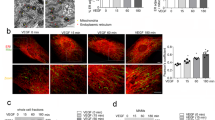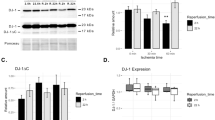A receptor for angiostatin was identified on the surface of endothelial cells as F1–F0 ATP synthase (Moser et al., 1999). Proc. Natl. Acad. Sci. U.S.A. 96, 2811–2816. This ectopic ATP synthase catalyzes ATP synthesis and is inhibited by angiostatin over a wide pH range. Endothelial cells grown at normal pH suffer no ill effects from this angiostatin-mediated inhibition of ATP synthase, whereas endothelial cells grown at low, tumor-like extracellular pH cannot maintain a normal intracellular pH and die. Angiostatin inhibits both ATP synthesis and ATP hydrolysis (Moser et al., 2001) and interferes with intracellular pH regulation (Wahl and Grant, 2002; Wahl et al., 2002). Although angiostatin administered intravenously is cleared from the circulation in a matter of minutes, angiostatin-mimetics that are more stable have potential for clinical application. An angiostatin-mimetic activity has recently been observed using a polyclonal antibody against the β catalytic subunit of ATP synthase. In order to explore the mechanism of action of angiostatin and its mimetics, further work needs to be done to evaluate clinical applicability, specificity, and contraindications for this class of therapeutics.
Similar content being viewed by others
Abbreviations
- HUVEC:
-
human umbilical vein endothelial cells
- MRI:
-
magnetic resonance imaging
- MCT:
-
H+-linked monocarboxylate transporter
- NHE:
-
sodium proton exchanger
References
Adams, D. J., Dewhirst, M. W., Flowers, J. L., Gamcsik, M., Colvin, O. M., Manikuman, G., Wani, M. C., and Wall, M. (2000a). Camptothecin analogues with enhanced antitumor activity at acidic pH. Cancer Chemother. Pharmacol. 4, 263–271.
Adams, D. J., Flowers, J. L., Pommier, Y., Colvin, O., Manikumar, G., Wani, M. C., and Wall, M. (2000b). 7-Substituted camptothecins exhibit enhanced potency and pH modulation in human breast cancer cells. In Proceedings of the 91st Annual Meeting of the American Association for Cancer Research, San Francisco, CA.
Adams, D. J., Wahl, M. L., Flowers, J. F., Sen, B., Colvin, O. M., Dewhirst, M. W., Manikumar, G., Wani, M. C., and Wall, M. E. (2005). Camptothecins with 7-alkyl substitutions have enhanced activity against human breast cancer: Impact of the tumor pH gradient. Cancer Chemother. Pharmacol. 205, 1–10.
Burwick, N. R., Wahl, M. L., Fang, J., Zhong, Z., Moser, T. L., Li, B., Capaldi, R. A., Kenan, D. J., and Pizzo, S. V. (2005). An inhibitor of the F1 subunit of ATP synthase (IF1) modulates the activity of angiostatin on the endothelial cell surface. J. Biol. Chem. 280, 1740–1745.
Contarino, M. R., Fang, J., Pizzo, S. V., and Wahl, M. L. (2004). The anti-angiogenic potential of pH regulation inhibitors. In Proceedings of the American Association for Cancer Research, Orlando, FL, 04-AB-1548-AACR.
Daliani, D. D., Papandreous, C. N., Thall, P. F., Wang, X., Perez, C., Oliva, R., Pagliaro, L., and Amato, R. (2002). A pilot study of thalidomide therapy in refractory solid tumour patients. Cancer 95, 758–765.
D'Amato, R. J., Loughnan, M. S., Flynn, E., and Folkman, J. (1994). Thalidomide is an inhibitor of angiogenesis. Proc. Natl. Acad. Sci. U.S.A. 91, 4082–4085.
Das, A. M. (1998). Regulation of mitochondrial ATP synthase activity in human myocardium. Clin. Sci. (Lond.) 94, 499–504.
Das, B., Mondragon, M. O. H., Sadeghian, M., Hatcher, V. B., and Norin, A. J. (1994). A novel ligand in lymphocyte-mediated cytotoxicity: Expression on the β subunit of H+ transporting ATP synthase on the surface of tumor cell lines. J. Exp. Med. 180, 273– 281.
DeMoraes, E. D., Fogler, W. E., Grant, D. S., Wahl, M. L., Leeper, D. B., Zrada, S., Malin, A., Connors, S., Fortier, A. H., Dabrow, M., Sidor, C., and Capizzi, R. L. (2001). Recombinant human angiostatin (rhA): A Phase I clinical trial assessing safety, pharmacokinetics (PK) and pharmacodynamics (PD). American Society of Clinical Oncology, phase I trials, Abstract 10.
Escudier, B., Lassau, N., Couanet, D., Angevin, E., Mesrati, F., Leborgne, S., Garofano, A., Leboulaire, C., Dupouy, N., and Laplanche, A. (2002). Phase II trial of thalidomide in renal-cell carcinoma. Ann. Oncol. 13, 1029–1035.
Figg, W. D., Arlen, P., Gulley, J., Fernandez, P., Noone, M., Fedenko, K., Hamilton, M., Parker, C., Kruger, E. A., Pluda, J., and Dahut, W. L. (2001). A randomized phase II trial of docetaxel (taxotere) plus thalidomide in androgen-independent prostate cancer. Semin. Oncol. 28, 62–66.
Folkman, J. (1971). Tumor angiogenesis: Therapeutic implications. N. Engl. J. Med. 285, 1182–1186.
Funatsu, H., Yamashita, H., Noma, H., Mochizuki, H., Mimura, T., Ikeda, T., and Hori, S. (2003). Outcome of vitreous surgery and the balance between vascular endothelial growth factor and endostatin. Invest. Ophthalmol. Vis. Sci. 44, 1042–1047.
Gutheil, J., and Finucane, D. (2002). Thalidomide therapy in refractory solid tumour patients. Br. J. Haematol. 110, 754.
Halestrap, A. P., and Price, N. T. (1999). The proton-linked monocarboxylate transporter (MCT) family: Structure, function, and regulation. Biochem. J. 343, 281–299.
Holash, J., Wiegand, S. J., and Yancopoulos, G. D. (1999). New model of tumor angiogenesis: Dynamic balance between vessel regression and growth mediated by angiopoietins and VEGF. Oncogene 18, 5356–5362.
Holmgren, L., O'Reilly, M. S., and Folkman, J. (1995). Dormancy of micrometastases: Balanced proliferation and apoptosis in the presence of angiogenesis suppression. Nat. Med. 1, 149–153.
Moser, T. L., Kenan, D. J., Ashley, T. A., Roy, J. A., Goodman, M. D., Misro, U. K., Cheek, D. J., and Pizzo, S. (2001). Endothelial cell surface F1–F0 ATP synthase is active in ATP synthesis and is inhibited by angiostatin. Proc. Natl. Acad. Sci. U.S.A. 98, 6656–6661.
Moser, T. L., Stack, M. S., Asplin, I., Enghild, J. J., Hojrup, P., Everitt, L., Hubchak, S., Schnaper, H. W., and Pizzo, S. V. (1999). Angiostatin binds ATP synthase on the surface of human endothelial cells. Proc. Natl. Acad. Sci. U.S.A. 96, 2811–2816.
Moser, T. L., Stack, M. S., Wahl, M. L., and Pizzo, S. V. (2002). The mechanism of action of angiostatin: Can you teach an old dog new tricks? Thromb. Haemost. 87, 394–401.
O'Reilly, M. S., Holmgren, L., Chen, C., and Folkman, J. (1996). Angiostatin induces and sustains dormancy of human primary tumors in mice. Nat. Med. 2, 689–692.
O'Reilly, M. S., Holmgren, L., Shing, Y., Chen, C., Rosenthal, R. A., Cao, Y., Moses, M., Lane, W. S., Sage, E. H., and Folkman, J. (1994a). Angiostatin: A circulating endothelial cell inhibitor that suppresses angiogenesis and tumor growth. Cold Spring Harbor Symp. Quant. Biol. 59, 471–482.
O'Reilly, M. S., Holmgren, L., Shing, Y., Chen, C., Rosenthal, R. A., Moses, M., Lane, W. S., Cao, Y., Sage, E. H., and Folkman, J. (1994b). Angiostatin: A novel angiogenesis inhibitor that mediates the suppression of metastases by a Lewis lung carcinoma. Cell 79, 315–328.
Orlowski, J., and Grinstein, S. (1997). Na+/H+ exchangers of mammalian cells. J. Biol. Chem. 272, 22373–22376.
Short, S. C., Traish, D., Dowe, A., Hines, F., Gore, M., and Brada, M. (2001). Thalidomide as an anti-angiogenic agent in relapsed gliomas. J. Neurooncol. 51, 41–45.
Soltys, B. J., and Gupta, R. S. (1999). Mitochondrial-matrix proteins at unexpected locations: Are they exported? Trends Biochem. Sci. 24(5), 174–177.
Soltys, B. J., Kang, D., and Gupta, R. S. (2000). Localization of P32 protein (gC1q-R) in mitochondria and at specific extramitochondrial locations in normal tissues. Histochem. Cell Biol. 114, 245–255.
Wahl, M. L., and Grant, D. S. (2002). Effects of microenvironmental extracellular pH and extracellular matrix proteins on angiostatin's activity and on intracellular pH. J. Gen. Pharm. (Vascular) 35, 1–10.
Wahl, M. L., Owen, C. S., and Grant, D. S. (2002). Low dose angiostatin induces intracellular acidosis and anoikis cell death in endothelial cells at tumor-like low pH. Endothelium 9, 205–216.
Yamagata, M., and Tannock, I. F. (1996). The chronic administration of drugs that inhibit the regulation of intracellular pH: In vitro and anti-tumour effects. Br. J. Cancer 73, 1328–1334.
Author information
Authors and Affiliations
Corresponding author
Rights and permissions
About this article
Cite this article
Kenan, D.J., Wahl, M.L. Ectopic Localization of Mitochondrial ATP Synthase: A Target for Anti-Angiogenesis Intervention?. J Bioenerg Biomembr 37, 461–465 (2005). https://doi.org/10.1007/s10863-005-9492-x
Issue Date:
DOI: https://doi.org/10.1007/s10863-005-9492-x




